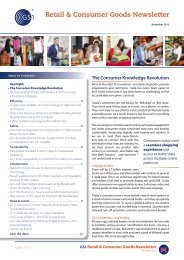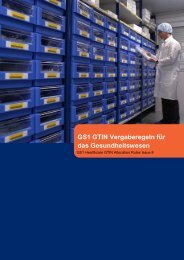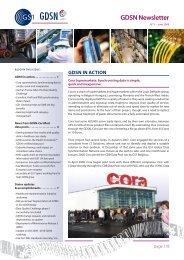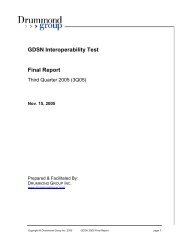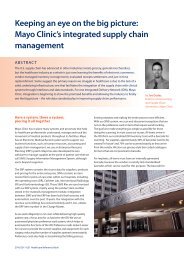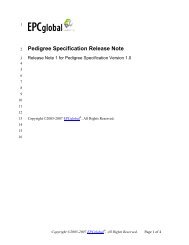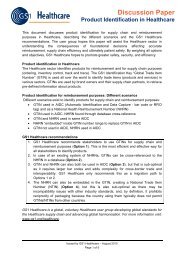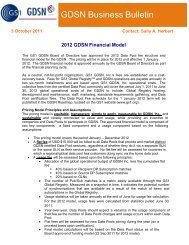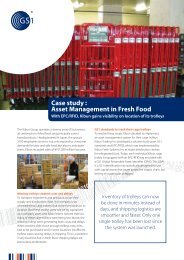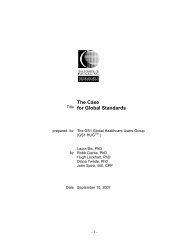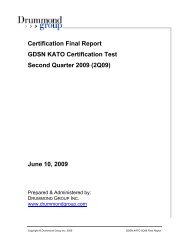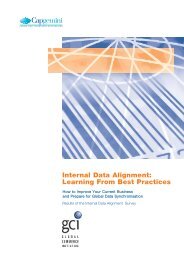Combined GS1 Healthcare and GS1 Healthcare User Group ...
Combined GS1 Healthcare and GS1 Healthcare User Group ...
Combined GS1 Healthcare and GS1 Healthcare User Group ...
Create successful ePaper yourself
Turn your PDF publications into a flip-book with our unique Google optimized e-Paper software.
29 th April 2009<br />
6.2 Exemption / Waiver Process<br />
Our recommendation is to include provision for a formal Waiver or Exemption process in any<br />
planned regulation / policy as it may be difficult to mark every pharmaceutical product with a<br />
bar code.<br />
a. Products might be too small, have no label space or even have no label.<br />
b. Manufacturer / Br<strong>and</strong> Owner should be provided the opportunity to request<br />
exemptions or waivers for specific products based on facts submitted.<br />
c. At minimum, the following categories of drug products should be considered as<br />
complex <strong>and</strong> potentially subject to waiver.<br />
1. Kits that contain any drug product<br />
2. Combination Drug / Device<br />
3. Drug products that are custom-made for a specific patient (such as antiallergy<br />
extracts manufactured for one patient)<br />
However, it should be noted that any limitations preventing physical bar coding do not<br />
prevent allocation of a GTIN to that particular item at that level of packaging.<br />
6.3 The extent of use of other bar coding systems, e.g. non-<strong>GS1</strong>, in the<br />
sector<br />
The 2003 study 8 conducted by <strong>GS1</strong> Australia, indicated that the only application of alternate<br />
identification <strong>and</strong> bar coding of medicines products was ‘internal / proprietary’ bar coding<br />
found only 1% of the shipper / case level packaging assessed. There was no alternate bar<br />
coding used for each / box packaging – the products either carried <strong>GS1</strong> bar codes or no bar<br />
code.<br />
Strong anecdotal evidence from industry representatives supports the above finding <strong>and</strong> so it<br />
is the conclusion of the stakeholders to this submission that the only identification <strong>and</strong> bar<br />
coding st<strong>and</strong>ard used in the medicines sector today is <strong>GS1</strong>.<br />
6.4 Product details currently encoded within the bar code<br />
Currently each / box unit pharmaceuticals in Australia carry a bar code containing the <strong>GS1</strong><br />
GTIN only.<br />
Higher level packaging, e.g., shrink wrap, case, shipper, may carry bar codes that contain the<br />
GTIN plus attribute information such as batch / lot number, expiry date, serial number, etc.<br />
The provision of this additional information is currently at the discretion of the manufacturer /<br />
organisation applying the bar code, <strong>and</strong> often this information is used internally within the<br />
manufacturer’s business for traceability functions.<br />
Where additional information exists, this is starting to be used by pharmaceutical wholesalers<br />
wishing to enable traceability within their own businesses.<br />
It is the recommendation of the stakeholders that the focus be placed on allocation of GTINs<br />
<strong>and</strong> physical bar coding at all levels of packaging (as appropriate) as a first step for any policy<br />
introduced. A longer term focus would then be provision of attribute information, e.g., batch<br />
<strong>and</strong> expiry date, that may be applied to the box / each or higher level packaging.<br />
8 Refer to Section 6.1<br />
<strong>GS1</strong> <strong>Healthcare</strong> Submission to TGC: Consideration of Bar Coding of Medicines Page 9 of 31



